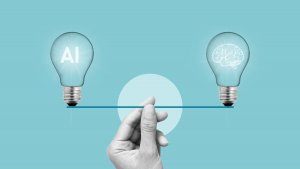By thoughtfully aligning AI tools with teaching philosophies, we can improve teaching experiences and effectiveness without compromising human values.
Why Starmer's AI Action Plan Needs Input From Education Experts
By thoughtfully aligning AI tools with teaching philosophies, we can improve teaching experiences and effectiveness without compromising human values.

The modern classroom is evolving at an unprecedented pace. Technological advancements have shaped both what we learn and how we learn, with Artificial Intelligence increasingly capturing attention.
Prime Minister Sir Keir Starmer's recent pledge to accelerate AI innovation in the UK identified teaching as part of his vision, particularly as a tool for reducing administrative burdens. While this focus on education is promising, its success hinges on careful implementation.
To ensure AI is integrated effectively and ethically, the UK government should actively engage both teachers - the classroom practitioners - and educators - a wider group of curriculum designers, researchers, and policymakers in developing AI technologies rooted in sound educational principles. Here's why:
How teachers teach
Pedagogy is at the heart of education—the methods, activities, and assessments teachers use to help students learn effectively. While teachers apply pedagogy in the classroom, a broader group of educators help shape the frameworks that inform teaching practices.
A strong pedagogical foundation enables teachers and the wider education community to understand what works, what doesn't, and how best to support students.
Teachers take on various pedagogical responsibilities, from adapting activities to suit different learning styles and ages to guiding students in discovering new ideas by structuring information to make it easier to understand and apply.
They continuously assess progress through informal observations and formal tests, ensuring learning stays on track. Good classroom management keeps students focused and ensures lessons run smoothly. Teachers also help students develop problem-solving skills by showing them strategies or helping them figure out their own.
Effective pedagogy is a collaborative effort—teachers bring real-time student insights, while curriculum designers and education experts create resources that align with best practices and learning objectives.
For AI to positively impact education, the tools teachers use must be designed around sound educational principles, aligning with both their needs and their students' goals—rather than allowing AI to dictate how learning takes place.
Given the ongoing and frequent launch of new tools, it is all the more important that teachers and those designing education materials are actively involved in the AI discovery process to determine what is fit for purpose.
Teachers and educators should be front and centre
The success of AI in education rests on teachers and the broader group of people designing education being part of the development process. EdTech is a key example of what happens when educators' input is overlooked.
Global investment in online education companies is at a decade low as free generative AI tools have entered the conversation. Meanwhile, AI investment continues to boom, with $51.4bn poured in this year alone.
Yet, global education remains a growth powerhouse, expected to reach almost $10T by 2030, with Early Childhood and Workforce Education among the fastest-growing segments. Within this, English language learning is projected to surpass $90bn by 2031, growing at 10.6% annually, driven by demand in urban markets and hybrid learning models.
Despite education’s potential, many Edtech companies are focusing on the wrong priorities and are instead racing to integrate generative AI tools. However, the real issue isn’t just AI competition but Edtech’s failure to integrate educators’ expertise at crucial stages of their development.
Without teacher and educator-led innovations, platforms focus on quick fixes rather than impactful education, leading to poor outcomes.
For us, any new AI products we introduce must have a measurable impact on student learning. For example, our Conversation AI feature mimics real-life conversations, giving students a practical opportunity to improve their English speaking skills in an anxiety-free environment before practising with people.
AI is therefore used to enhance, not replace human conversations. Meanwhile, our AI Chatbot helps students at every proficiency level and offers customised resources like dictionaries and grammar guides.
In both cases, the technology was the easy part. What was harder – and much more successful – was the assurance of positive student outcomes. Our educational effectiveness team, made up of teachers who work front and centre, spent months working with the technology team to ensure the AI provided actual education outcomes.
Using AI to augment, not replace teachers
For Starmer's plan to succeed, AI must be integrated into classrooms to enhance, rather than replace, the critical human skills that define education—such as creativity, critical thinking, and ethical reasoning. AI should be used to augment teachers' capabilities, not replace them. As educators, we can leverage AI where it's beneficial but equally, we must understand its limitations.
It’s important to reflect on what AI is and what it is not. Large Language Learning Models (LLMs) are a collection of words and a statistical model that selects in which order words can be put together (the answer) in the context of some words that precede them (the prompt).
LLMs have no knowledge and don’t understand anything about education. However, they can be used to aid those people that do know i.e., an education expert in the same way that engineers use GPTs to accelerate the process of writing code. AI can be very helpful in accelerating the “brain to live” cycle, but left alone they are useless.
AI can't be plugged in everywhere, but it can empower teachers. For example, automating repetitive tasks like grading exams and scheduling classes. This helps teachers do what they do best: inspire, motivate and challenge students. AI can personalise the learning experience and ensure the pace of learning is right for each ability, skill and confidence level.
Educators who use AI-driven insights—including teachers in the classroom and those designing learning materials—to understand their students' strengths and weaknesses can better nurture analytical reasoning, confidence, and interpersonal skills that AI alone can't do.
Technology can help teachers take more of a coaching role rather than being overburdened by administrative tasks. However, the key is ensuring teachers are fully onboarded and engaged with the tools at their disposal so they can use them to their full potential.
The future of the classroom
For Starmer's vision to become a reality, educators at every level must remain at the centre of AI's role in education. Without their involvement, AI risks being built for efficiency rather than true learning impact.
By thoughtfully aligning AI tools with teaching philosophies, we can improve teaching experiences and effectiveness without compromising human values. AI can empower both teachers and students, complementing the personal elements of learning.
At the same time, preparing students for an AI world is essential. We must ensure they have the skills to properly evaluate AI-generated outputs rather than accept them at face value. Our role is to cultivate irreplaceable human qualities and ensure people remain at the centre of an increasingly AI-driven world.
Roberto Hortal is Chief Product and Technology Officer at Wall Street English
Thanks for signing up to Minutehack alerts.
Brilliant editorials heading your way soon.
Okay, Thanks!

